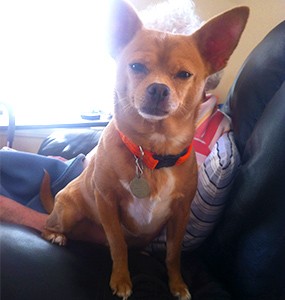Tracheal collapse is exactly what it sounds like: a condition in which a dog’s trachea, or “windpipe,” collapses and causes airway obstruction and breathing problems.
The trachea is a tube made up of many rings of cartilage; these rings hold the trachea open, enabling it to transport air to and from the lungs. Sometimes, those rings weaken and collapse, and when they do, air is squeezed through a smaller-than-normal space. The result is a very noticeable, “honking” cough.  Causes, Signs, and Symptoms
Causes, Signs, and Symptoms
The cause of tracheal collapse is unknown, but it is widely regarded as genetic. It primarily affects “toy” breeds – small dogs, such as Yorkshire Terriers, Chihuahuas, Shih Tzus, and others – and though it can appear in dogs of any age, it appears more often in middle-aged to older dogs as the rings of the trachea weaken and collapse over time.
Besides the telltale “honking cough,” other symptoms include:
- Exercise intolerance
- Labored breathing
- Bluish tinge to the gums
These symptoms can be worsened by obesity, excitement, eating and drinking, irritants such as smoke or dust, and hot and humid weather.
Diagnosis
The most obvious sign of tracheal collapse is the “honking” cough, but a definitive diagnosis requires additional testing, which might include:
- X-rays
- Fluoroscopy (similar to an x-ray “movie”), which allows veterinarians to watch the trachea as a dog inhales and exhales. Fluoroscopy, however, is not widely available.
- Bronchoscopy, which can be used to diagnose tracheal collapse as well as grade its severity.
Your veterinarian may also recommend a complete blood count and chemistry test to look for infection, inflammation, or metabolic disease that could complicate the tracheal problem.
Treatment
Your veterinarian will recommend medication, surgery, or some combination of the two. The most common medications prescribed are cough suppressants. Other prescriptions may includebronchodilators, anti-inflammatory medication, or antibiotics. In obese dogs, weight loss helps and is strongly recommended.
In severe cases – when medication is minimally effective and tracheal collapse has severely affected the dog’s quality of life – surgery can be a viable option. This might involve installing prosthetic tracheal rings to reinforce the trachea. This surgery is not always straightforward and your veterinarian may recommend consultation with a surgical specialist. Most owners report that surgery results in an improved quality of life for their pet.
Prognosis and Management
Medication does not cure tracheal collapse and is used to manage the condition. This means that treatment is ongoing, and even with diligent control, most dogs continue to experience some symptoms of tracheal collapse. In some patients, surgery can significantly reduce clinical signs of tracheal collapse. Whether managed medically or surgically, dogs with tracheal collapse require regularly scheduled check-ins with a veterinarian for physical exams, rechecking of x-rays, and periodic blood work to screen for possible side effects from the medications.
When it comes to treatment and management of tracheal collapse, your veterinarian will recommend the best course of action in order to give your dog the longest and happiest life possible.
If you have any questions or concerns, you should always visit or call your veterinarian – they are your best resource to ensure the health and well-being of your pets.
